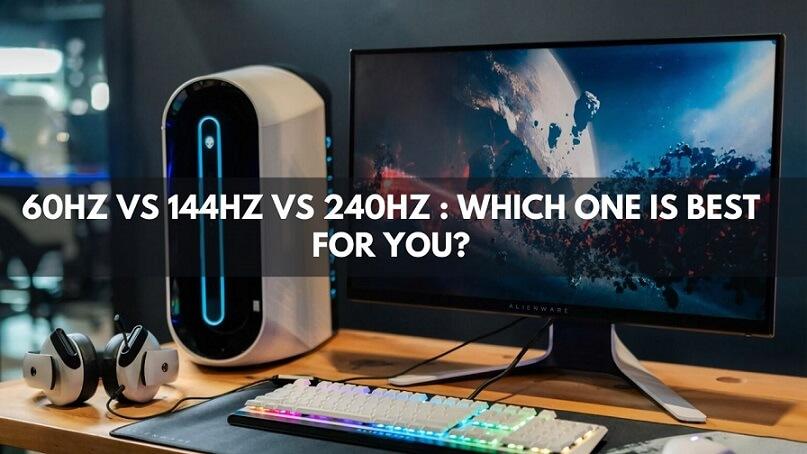Welcome to our guide on 60hz vs 144hz vs 240hz where you will learn key differences and which one is best for you.
While purchasing any new monitor, you have to check out some important features, and the response rate is one of them.
Some monitors come with 60hz refresh rates, some of them come with 144hz and some of them comes with 240hz refresh rates.
BUT, which is best suitable for you?…. ( Also budget-friendly )
So, here in this article, we are going to compare 60hz vs144hz vs 240hz refresh rates, and later we will figure out which is best for you.
Purchasing a monitor will all good specifications is one of the key features so that you will get a much better viewing experience.
SPOILER ALERT:
Before we get started, I want to give you a short brief of this article. 144hz refresh rate monitors are the winners of this time. They have better picture quality, better gaming experience, and also they didn’t cost too much high.
However, there are lots of cheap 144hz monitors are available in the market and they are the best choice for those who loved gaming, or for those who want some premium good-looking monitors in the budget price range.
A 144hz refresh rates monitors are the winner in the budget price range.
But, if you want to improve your gaming experience to the NEXT level, then 240hz refresh rate monitors are best.

60hz vs144hz vs 240hz Test & Comparison
If you play games on PC then you must heart about 144hz refresh rates and 240hz refresh rates. If you are using standard 60hz refresh rate monitors, then there are more chances that you get some blurry images and scenes while playing racing games.
| Feature | 60Hz Monitor | 144Hz Monitor | 240Hz Monitor |
| Refresh Rate | 60Hz | 144Hz | 240Hz |
| Frame Rate Cap | Up to 60 frames per second (fps) | Up to 144 fps | Up to 240 fps |
| Smoothness and Fluidity | Lower refresh rate, noticeable motion blur | Improved smoothness and reduced motion blur | Exceptionally smooth and minimal motion blur |
| Gaming Experience | Decent, but may have input lag | Enhanced responsiveness and reduced input lag | Ultra-responsive gaming experience |
| Competitive Gaming | May provide a competitive edge | Ideal for competitive gamer | A maximum advantage for competitive gamers |
| Visual Fidelity | Good, but may have a motion blur | Improved clarity and reduced motion blur | Exceptional clarity and minimal motion blur |
| Graphics Card Requirements | Can run on mid-range graphics cards | Requires a more powerful graphics card | Requires a high-end graphics card |
| Screen Tearing | Possible without adaptive sync technology | Less screen tearing with adaptive sync (e.g., G-Sync) | Reduced screen tearing with adaptive sync |
| Motion Handling | Limited ability to handle fast-moving images | Improved motion handling and smoother transitions | Best-in-class motion handling and seamless transitions |
| Response Time | Average to high response time | Faster response time | Ultra-fast response time |
| Budget-Friendly Options | Widely available and more affordable | Available in mid-range price range | Higher-end and more expensive options |
| Suitable For | Everyday use, non-competitive gaming | Casual and competitive gaming | Competitive gaming and professional use |
| Recommended Usage | Office work, general entertainment | Gaming, fast-paced content | Gaming, professional applications |
| Impact on Performance | Moderate impact on system performance | Moderate to high impact on system performance | High impact on system performance |
| Upgrade Consideration | Significant improvement from 60Hz | Noticeable improvement from 60Hz | Incremental improvement from 144Hz |
| Cost | Relatively cheaper | Moderate price range | Expensive |
| Future Proofing | Limited future proofing | Relatively future proof | Relatively future proof |
This is because a 60hz refresh rates monitors can’t able to render more than 60 images in one second.
Sounds tricky? Well, first of all, we need to understand what is refresh rates stand for?
Refresh rates stand for how quality your screen is able to update. Its unit is Hertz or “Hz”.
Basically, refresh rates counts the total number of times your monitors turn on and off in one second.
A 60hz refresh rate monitors turn on and off its display 60 times in one second. Or you can say that it refreshes 60 pictures in one second.
How Refresh Rate Impact Our Viewing Experience
The refresh rate impacts your viewing experience a lot.
A high refresh rate monitor means that the image will update much quicker and you will get much smooth image transitions.
Suppose you have a 60hz refresh rate monitor & and you have a good GPU and good PC configuration that can easily deliver more than 100 frames per second while rendering that game. You can slightly increase these numbers by overclocking your monitor.
At that time, due to the low refresh rates of your monitor, you will only get a maximum of 60 frames per second while playing FPS games.
No matters how high-end configuration you will use.
So, In short, you can say that –
- A 60hz Refresh Rate monitor can deliver up to 60 frame rates.
- A 144hz Refresh rate monitor can deliver up to 144hz frames per second
- And, A 240 Hz High refresh rate monitor can deliver up to 240 frames per second easily.
Eh! But Wait. To render 240 frames per second needs a much higher GPU to sync and to justify frames. So Don’t purchase any 240 Hz monitor blindly. Also sometimes, you need to choose the right connection cable to connect your CPU with your monitor to achieve the right refresh rates.
Purchasing a 60hz monitor for gaming purposes is always not recommended. As it will cap your frames to 60 frames per second only.
Whereas, there are lots of monitors are available that come with 144hz refresh rates, and also they allow you to render up to 144 frame rate.
And, Playing games on more than 100 fps will give you a much better gaming experience.
FAQs
Is there a big difference between 144Hz and 240Hz?
Yes, there is a significant difference in display quality between a 144Hz and 240Hz monitor. The higher refresh rate of 240Hz provides a more fluid and smoother display, especially for fast-moving objects and in fast-paced games.
Is 60Hz better than 240Hz, which is a higher refresh rate monitor?
No, 60Hz is not better than 240Hz. Higher refresh rates monitor, such as 240Hz, offer a more responsive gaming experience, particularly in competitive games where quick reactions are crucial.
Is it worth upgrading from 144Hz to 240Hz?
Whether upgrading from 144Hz to 240Hz is worth it depends on your needs and preferences. If you are a gamer or require a high-refresh-rate display for your work, the upgrade may provide noticeable benefits. However, for most casual users, the difference between 144Hz and 240Hz may not be significant enough to justify the cost.
Is there a big difference between 60Hz and 240Hz?
Yes, there is a substantial difference between 60Hz and 240Hz. The higher refresh rate of 240Hz offers a much smoother and more fluid display, especially for gaming and fast-moving content.
Can you notice the difference between 144Hz and 60Hz?
Yes, the majority of people can perceive the difference between 144Hz and 60Hz. The higher refresh rate of 144Hz provides a more fluid and smoother display, resulting in improved visual clarity and responsiveness.
Is it worth upgrading from 60Hz to 144Hz?
If you are a gamer or require a high-refresh-rate display for your work, upgrading from 60Hz to 144Hz is a worthwhile investment. The higher refresh rate of 144Hz delivers a more responsive gaming experience and smoother visuals, particularly in fast-paced and demanding games.
Conclusion
So, this is the complete comparison between 60hz vs144hz vs 240hz refresh rate monitors.
Purchasing the 144hz refresh rate monitor is a much better option than purchasing a 60hz or 240hz refresh rate monitor.
But, If you have a really high budget, then no doubt, go with a 240hz refresh rate monitor.
A higher refresh rate is much better.
So, Hope you will find this article helpful. Also, If you have any questions related to it, then you can ask it in the comment section.
